By Jim Henderson, CMP Pistol Coordinator
Today's feature is from the Civilian Marksmanship Program.
As the title implies, this is going to be a short overview of how to shoot, or the ins and outs, of a bullseye match – things you should and shouldn’t do before, during and after a match.
So, let’s just jump right in, from the beginning…
Before the Match:
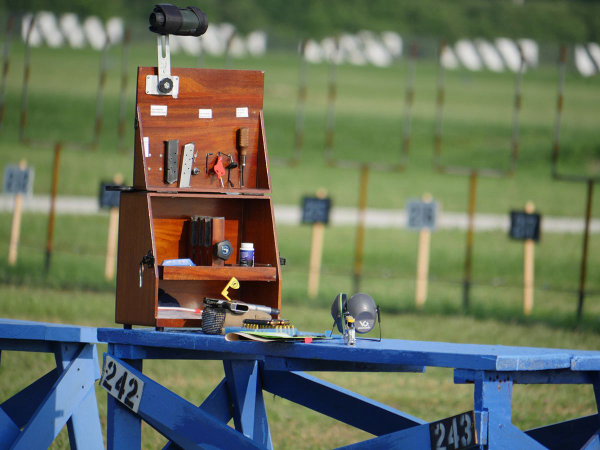
Practice and preparation are key to having fun and enjoying a match you paid your hard-earned money to shoot. I believe in practicing the things you may not be as good at more often than what you do well. Having awesome slow fire is great, but two-thirds of your match is sustained fire. If you aren’t where you think you should be in, say, rapid fire – it’s in your best interest to get better at it! In my opinion, if I had limited resources and time, I would train nothing but rapid fire.
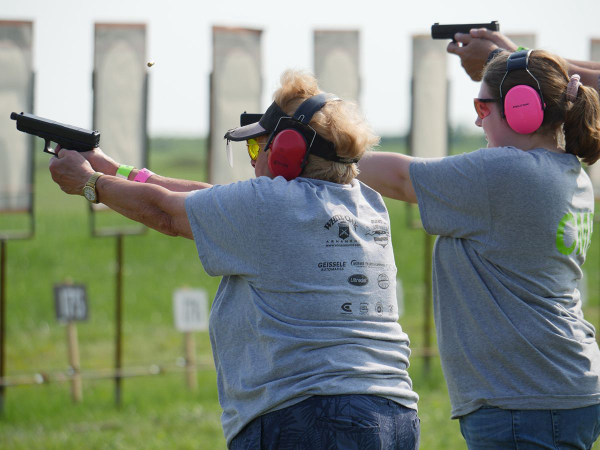
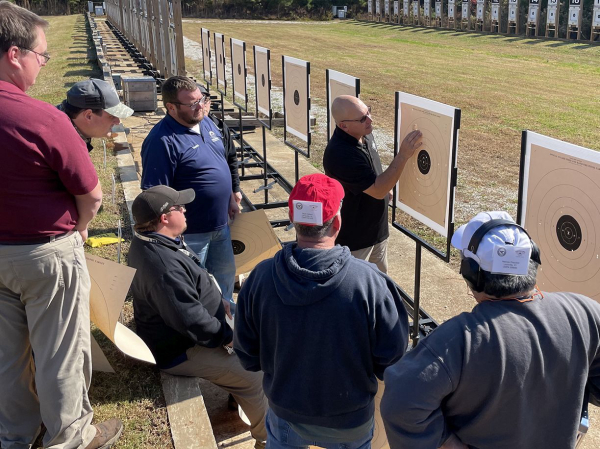
Here’s a list of things I like to check the night before I’m heading to a match.
This isn’t an all-inclusive list – just suggestions.
Go to bed at your normal time. This is pretty important to help promote that stress-free enjoyment of your match the next day.
The Day of the Match:
Leaving the house with ample time to get to the range is also very important. Don’t be that person that shows up to the firing line with 20 seconds left in the prep period. Not only are you detrimental to yourself, but you’re a distraction to the other shooters that spent their hard-earned money to be there as well. Treat your fellow competitors as you wish to be treated.
Now that you’ve arrived to the range with plenty of time to spare, getting checked in and picking up your score cards is a good idea. When you arrive early, there’s a great chance that you’ll miss a line at check in.
If the range allows, get your box set on your point. If you brought a chair, get it set up. Make yourself at home!
Preparing to Shoot:
About 20 to 30 minutes from your prep time, start warming up. You can do good things by warming up just prior to leaving the house as well. The only warm up I believe necessary is a few minutes of line drill. By that, I mean find a straight, vertical line somewhere you can move your arm up and down. Corners of a room, a piece of tape on an overhead cover post, whatever – as long as you can stand in your shooting stance and move your firing arm up and down along that line.
In the drill, you trace the line with your empty hand, superimposing your thumb nail on the line. Then, you’re going to trace that line as best you can from 45 degrees down, to 45 degrees up, and back down again. Go for a minute of motion and then 30 seconds of complete rest. Let your arm go to your side and let it hang. It’s not about quantity, but quality. At the range, I wouldn’t do more than a couple minutes of this. All we’re looking to do is warm the muscles up.
Once you’re allowed to approach the line and open your boxes, get everything set up the way you want it. I put everything in the exact same place every single time I shoot. I could put my hand on my screwdriver with my eyes closed if I had to. Then, make sure your magazines are loaded. In bullseye, it’s always five rounds per magazine, no matter what.
Once you’ve got that done, check to make sure you have the correct scorecard ready to go with whatever you’re going to take down range to score. The great thing about the CMP scorecards is if you aren’t familiar with the course of fire, the explanation of what to do is right above the shot value boxes. Plus, the Chief Range Officer (CRO, the person giving the commands) will tell you exactly what’s coming next. Also, make sure you put your competitor label in the appropriate place on the card you’re scoring.
Normally there’s a few minutes between being called to the line and starting your three-minute preparation period. If not, the things I just mentioned are more important than anything else. If you still have time left in your three-minute prep, use it to dry fire a couple of times. In reality, your arm and body are ready to go – now we just want to connect the brain to the finger.
Firing the Match:
So now we come to the actual shooting portion. The specifics of what I think needs to happen to deliver your shot process to the best of your ability at any given moment is a story for another day. What I will say is that it’s important to keep the same positive mindset throughout the match. Yes, be competitive, but have fun at the same time.
Alibis and Malfunctions:
If during your time shooting you should happen to have an alibi/malfunction, there are a few things to consider. First and foremost, if you do have a malfunction and wish to take a re-fire, DON’T TOUCH THE PISTOL! If you do touch the pistol, this would be deemed “an attempt to clear the malfunction.” Once you do that, there is no re-fire allowed. So, simply continue to hold the gun pointed down range and raise your non-firing hand. A Range Officer (RO) will come by and initiate the process with you from there.
Typically, competitors don’t seek a re-fire for a malfunction during slow fire as there is plenty of time to fix a malfunction in the time allowed. With that, if you can’t get your pistol up and running in a reasonable time during your string of fire, raise your hand for an RO. At this point, you will need to declare that particular pistol disabled.
If you have a backup pistol to shoot, inform the RO and follow their instructions for clearing and casing the broken pistol. That pistol may not be reintroduced to the same match without being repaired. You also have the option to swap out a gun as above should you have a malfunction during timed and rapid-fire portions. The definition for a malfunction is in the CMP Pistol Competition Rules, Rule 5.1.5 on page 47. Competitors may view the Competition Rules at https://thecmp.org/competitions/cmp-pistol-program/.
When Firing is Complete:
Once you’re done with your shooting, quietly insert your ECI (empty chamber indicator) and reload your magazines. Be courteous to your fellow competitors around you. If you need to discuss things with yourself or a friend, step back and do it as far away from the line as practical.
Once the line is clear, make sure you take the scorecard, stapler (I always check how many staples I have left prior to the first time I go down range during a match), repair center (pasters or tape if you need it) and something to write with.
Then, go to the target you’re scoring first – not your own. I know this is hard for some people as they want to see what their score is. I get it, but I suggest doing it after you have scored the target you’re supposed to be scoring so that competitor isn’t waiting on you. Once you’ve scored the target, write the score on the target away from any shot holes. I like to write mine in the upper right-hand corner of the repair center area.
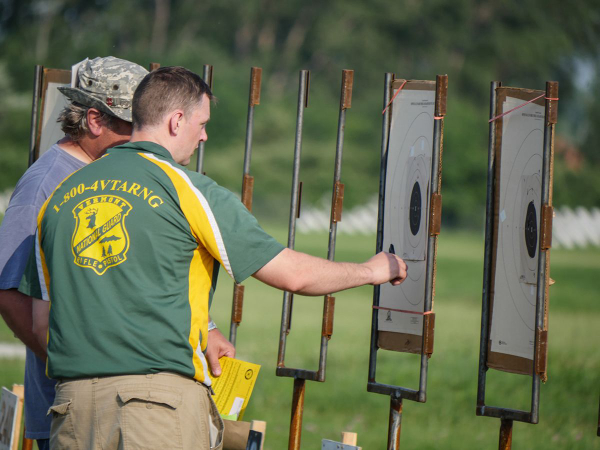
Scoring:
When scoring a target, call it as you see it. If you think the shot is a certain value, write that value down. If you’re unsure and think it’s close, you, as a competitor, can use an overlay or scoring template. You may not touch the target in such a way as to disturb the shot holes – so, no plugs, pens, pencils or fingers stuck in the shot holes.
Once that target is scored, it is up to the competitor to agree or disagree with your scoring. Don’t waste time asking him/her what this shot or that shot should be. Once the competitor has had a chance to look, he or she very well may disagree with a shot or two. That’s fine – that’s where to RO comes in. At this point, the person being scored calls for a “plug.” The RO will come over, and the first question they should ask is “Do agree on the number of hits?” Both you, as the scorer, and the competitor you’re scoring need to agree on the number of hits. This is simply because if there is a shot that can’t be found, the target cannot be plugged. Plugging a double shot hole is not allowed, and the missing shot could be a double.
Scoring Challenge:
Once both of you agree on the number of hits, the RO can plug the shot in question. Once the RO inserts the plug, it must stay until you and the competitor agree. It is not up to the RO to score the target. If after looking at the plugged shot, you two still don’t agree, then the target can be challenged. The competitor pays a $3 challenge fee and the RO removes the target (with plug still in the target) and replaces it with a clean one. You repair your target, assuming you agree with your score, and continue back up range to your firing point. The challenged target will come back after it has been looked at by the Jury for determination.
Once back, annotate the scorecard with the results of the challenge. If you need to change a score in one of the boxes, simply run a single line across the original score. Then, write the correct score in where you can, as neatly as you can, and initial it. If the competitor won the challenge, he or she gets the $3 back.
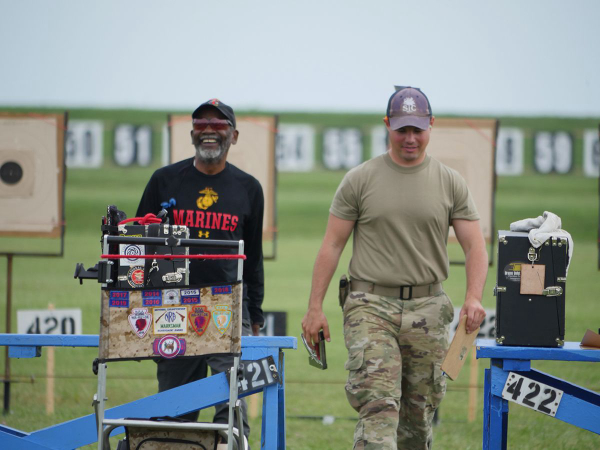
Now you’re ready for the range.
I hope this short overview has given you an idea of the do’s and don’ts of shooting a Pistol match. Stay safe and have fun! I look forward to seeing you on the range!
About Jim Henderson:
Jim Henderson is a retired member of the U.S. Army Marksmanship Unit (USAMU) where he served for over 30 years. He earned his Distinguished Pistol Badge in 1989 and went on to earn several honors, including recognition as a nine-time winner of the President’s Pistol Match (one of the most prestigious events held at the annual Camp Perry National Matches) and is the National Record holder of the event.
Henderson is also the National Record holder and a four-time winner of the National Trophy Individual Match, a two-time National Rifle Association National Outdoor and Indoor Pistol Champion and a nine-time Pistol Inter-Service Champion and record holder. He has held positions as a member of the USA Shooting Board of Directors, Pistol Athlete Representative and has successfully realized a number of training programs within the Army over the course of his tenure. Currently, Henderson serves as the director of pistol and rifle ranges at Cardinal Shooting Center in Marengo, Ohio, and is also CMP’s pistol program coordinator.
Learn more about CMP’s Pistol Program by visiting https://thecmp.org/competitions/cmp-pistol-program/.
The Civilian Marksmanship Program is a federally chartered 501 (c) (3) non-profit corporation. It is dedicated to firearm safety and marksmanship training and to the promotion of marksmanship competition for citizens of the United States. For more information about the CMP and its programs, log onto www.TheCMP.org.